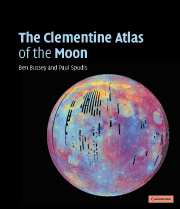Preface to original edition
Published online by Cambridge University Press: 05 September 2013
Summary
An atlas serves many purposes: the need to have a ready compilation of maps to locate features, a desire casually to explore an unknown territory, or a summary of existing knowledge about a barely familiar place. In our case, the impetus and inspiration to make an atlas based on data from the highly successful Clementine mission in 1994 began many years ago, even before the Clementine mission. An out-of-print book, The Times Atlas of the Moon (edited by H. A. G. Lewis, Times Newspapers Limited Printing House, London, 1969) has been a boon to serious lunar students for many years. This book, although containing much ‘slick’ front matter hyping the impending landing of Apollo 11 on the Moon, conveniently bound together all of the published US Air Force LAC (Lunar Astronautical Charts) series of lunar maps, originally published separately at a scale of 1:1000000. The LAC series consisted of airbrushed, shaded-relief maps, overlain by topographic contour lines (determined from Earth-based telescopic images) and the nomenclature of lunar features. Having this wonderful map series in a single, bound, easy-to-reference volume was very handy and this book is both used and treasured by working lunar scientists to this day (hence, its rarity and cost on the used-book market).
As wonderful as the Times Atlas was and is, it has several drawbacks, aside from its unavailability. It uses old versions of the LAC charts – these maps were drawn in the early 1960s, from telescopic images, and the subsequent 40 years of spacecraft exploration have produced an abundance of exciting, new images and data with which to compile an atlas.
- Type
- Chapter
- Information
- The Clementine Atlas of the Moon , pp. ix - xPublisher: Cambridge University PressPrint publication year: 2004



